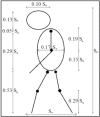Motion cue analysis for parkinsonian gait recognition
- PMID: 23407764
- PMCID: PMC3568887
- DOI: 10.2174/1874120701307010001
Motion cue analysis for parkinsonian gait recognition
Abstract
This paper presents a computer-vision based marker-free method for gait-impairment detection in Patients with Parkinson's disease (PWP). The system is based upon the idea that a normal human body attains equilibrium during the gait by aligning the body posture with Axis-of-Gravity (AOG) using feet as the base of support. In contrast, PWP appear to be falling forward as they are less-able to align their body with AOG due to rigid muscular tone. A normal gait exhibits periodic stride-cycles with stride-angle around 45o between the legs, whereas PWP walk with shortened stride-angle with high variability between the stride-cycles. In order to analyze Parkinsonian-gait (PG), subjects were videotaped with several gait-cycles. The subject's body was segmented using a color-segmentation method to form a silhouette. The silhouette was skeletonized for motion cues extraction. The motion cues analyzed were stride-cycles (based on the cyclic leg motion of skeleton) and posture lean (based on the angle between leaned torso of skeleton and AOG). Cosine similarity between an imaginary perfect gait pattern and the subject gait patterns produced 100% recognition rate of PG for 4 normal-controls and 3 PWP. Results suggested that the method is a promising tool to be used for PG assessment in home-environment.
Keywords: Gait impairment; Gait video analysis; Image processing.; Parkinson’s disease.
Figures








Similar articles
-
Effect of bilateral subthalamic nucleus stimulation on gait in Parkinson's disease.Brain. 2001 Aug;124(Pt 8):1590-600. doi: 10.1093/brain/124.8.1590. Brain. 2001. PMID: 11459750 Clinical Trial.
-
Gait stride-to-stride variability and foot clearance pattern analysis in Idiopathic Parkinson's Disease and Vascular Parkinsonism.J Biomech. 2019 Jul 19;92:98-104. doi: 10.1016/j.jbiomech.2019.05.039. Epub 2019 May 30. J Biomech. 2019. PMID: 31182234
-
Familiarity with music influences stride amplitude and variability during rhythmically-cued walking in individuals with Parkinson's disease.Gait Posture. 2021 Jun;87:101-109. doi: 10.1016/j.gaitpost.2021.04.028. Epub 2021 Apr 21. Gait Posture. 2021. PMID: 33895635
-
Gait dynamics in Parkinson's disease: relationship to Parkinsonian features, falls and response to levodopa.J Neurol Sci. 2003 Aug 15;212(1-2):47-53. doi: 10.1016/s0022-510x(03)00104-7. J Neurol Sci. 2003. PMID: 12809998
-
Stride length regulation in Parkinson's disease. Normalization strategies and underlying mechanisms.Brain. 1996 Apr;119 ( Pt 2):551-68. doi: 10.1093/brain/119.2.551. Brain. 1996. PMID: 8800948
Cited by
-
Gait Impairment Analysis Using Silhouette Sinogram Signals and Assisted Knowledge Learning.Bioengineering (Basel). 2024 May 10;11(5):477. doi: 10.3390/bioengineering11050477. Bioengineering (Basel). 2024. PMID: 38790344 Free PMC article.
-
Gait-Guard: Turn-aware Freezing of Gait Detection for Non-intrusive Intervention Systems.IEEE Int Conf Connect Health Appl Syst Eng Technol. 2024 Jun;2024:61-72. doi: 10.1109/chase60773.2024.00016. Epub 2024 Aug 5. IEEE Int Conf Connect Health Appl Syst Eng Technol. 2024. PMID: 39262653 Free PMC article.
-
FoG-Finder: Real-time Freezing of Gait Detection and Treatment.IEEE Int Conf Connect Health Appl Syst Eng Technol. 2023 Jun;2023:22-33. Epub 2023 Jul 21. IEEE Int Conf Connect Health Appl Syst Eng Technol. 2023. PMID: 37736618 Free PMC article.
-
Markerless Motion Capture to Quantify Functional Performance in Neurodegeneration: Systematic Review.JMIR Aging. 2024 Aug 6;7:e52582. doi: 10.2196/52582. JMIR Aging. 2024. PMID: 39106477 Free PMC article.
References
-
- Niewboer A. “Freezing of Gait: Problem analysis and rehabilitation strategies,”. Parkinsonism Relat. Disord. 2006;vol. 12, no. 2:S53–S54.
-
- Riva G, Wiederhold BK, Molinari EE. Virtual Environments in Clinical Psychology and Neuroscience. Amsterdam: Ios Press,; 1998.
-
- Bloem BR, Grimbergen YA, Cramer M, Willemsen M, and Zwinderman AH. “Prospective assessment of falls in Parkinson's disease,”. J. Neurol. 2001;vol. 248, no. 11:950–8. - PubMed
-
- Ghassemi M, Lemieux S, Jog M, Edwards R, and Duval C. “Bradykinesia in patients with Parkinson's disease having Levodopainduced dyskinesias,”. Brain Res. Bull. 2006;vol. 69:512–518. - PubMed
LinkOut - more resources
Full Text Sources
Other Literature Sources
